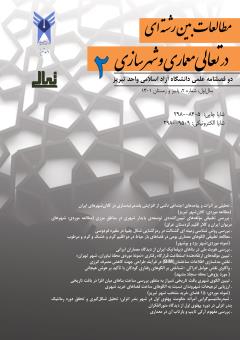ارزیابی ترجیحات شهروندان نسبت به الگوهای ساخت فضاهای خرید شهری (نمونه موردی: 15 فضای خرید منتخب شهر تبریز)
محورهای موضوعی : طراحی شهرینازنین فرهودیان 1 , اکبر عبدالهزاده طرف 2 , آرش ثقفی اصل 3 , مرتضی میرغلامی 4
1 - دانشجوی دکتری طراحی شهری، گروه شهرسازی، واحد تبریز، دانشگاه آزاد اسلامی، تبریز، ایران.
2 - استادیار گروه شهرسازی، واحد تبریز، دانشگاه آزاد اسلامی، تبریز، ایران.(نویسنده مسئول)taraf_1981@iaut.ac.ir
3 - استادیار گروه شهرسازی، واحد تبریز، دانشگاه آزاد اسلامی، تبریز، ایران.
4 - دانشیار دانشکده معماری و شهرسازی، دانشگاه هنر اسلامی، تبریز، ایران.
کلید واژه: تبریز, مال, الگوی ساخت, فضای خرید, ترجیحات,
چکیده مقاله :
فضاهای خرید در شهر تبریز، در طی زمان الگوهای ساخت متنوعی را از بازار تا خیابان تجاری و در دو دهه اخیر مالها تجربه کردهاند. با توجه به اهمیت جایگاه شهروندان بهعنوان مصرفکنندگان فضاهای تجاری در تعیین مسیر استراتژیهای توسعه فضاهای خرید، هدف از انجام این پژوهش ارزیابی ترجیحات شهروندان نسبت به الگوهای ساخت فضاهای خرید شهری تعیین گردید. پژوهش حاضر با روش میدانی و از نوع موردپژوهی در سال 1401 در جامعه آماری شهروندان تبریز انجام گردید. ابتدا با انجام مطالعات میدانی الگوهای ساخت فضاهای خرید تبریز مورد شناسایی قرار گرفت. سپس برای تعیین نمونه موردی مطالعه، 15 فضای خرید از میان 8 الگوی ساخت شناسایی شده انتخاب گردید. دادههای جمعآوری شده از طریق ابزار پرسشنامه، با نرمافزار SPSS و آزمون فریدمن مورد تجزیهوتحلیل قرار گرفتند. یافتههای حاصل از پژوهش بیانگر این است که پنج فضای خرید ولیعصر، لالهپارک، اطلس، تربیت و شریعتی (شهناز) از نظر پاسخگویان به ترتیب از اولویت بیشتری برخوردار هستند. علاقهمندی و ترجیح مردم بیشتر بهسمت فضاهای خرید با الگوی ساخت پیادهراه، مال و خیابان تجاری است. الگوهای ساخت میدانبازار، بازار زیرزمینی، پلبازار در این میان نتوانستهاند رتبه مناسبی را کسب کنند. با استناد به نتایج حاصل از پژوهش میتوان گفت بهکارگیری الگوی ساخت مال بهصورت مستقل و ایزوله از بافت شهری؛ کپیبرداری از مصادیق بینالمللی بدون هیچ گونه پیوند با زمینه و بستر موجود محسوب میشود. برای اینکه فضاهای خرید امروزی بتوانند از پس وظیفهاشان در قبال ایفای نقش بهعنوان فضای شهری به درستی برآیند لازم است که اتصالات و ارتباطات خود را با فضاهای خرید اصیل حفظ نمایند. بنابراین مکلف کردن بخش خصوصی از جانب مدیریت شهری در ساخت فضاهای خرید در اتصال با بافت شهری پیرامون از طریق الگوهای ساخت پیادهراه و خیابان تجاری، میتواند گسست ایجاده شده در تجربه خرید از شهر را ترمیم نماید.
Shopping spaces in Tabriz have experienced various construction patterns over time, from the bazaar to the commercial street and in the last two decades, malls. Considering the importance of the position of citizens as consumers of commercial spaces in determining the path of development strategies of shopping spaces, the purpose of this research was to evaluate the preferences of citizens regarding the construction patterns of urban shopping spaces. The current research was conducted with field method and case study type in 1401 in the statistical population of Tabriz citizens. Sampling was done randomly and according to the diversity of demographic characteristics, including age and gender. The sample size was obtained by Cochran's formula of 385 people. First, by conducting field studies, Tabriz shopping centers were classified based on eight identified construction patterns. Then, among them, 15 prominent shopping spaces in terms of historical record, functional scale, size and attraction of local residents and tourists in ten areas of the city were selected as case studies. The collected data through the questionnaire tool were analyzed with SPSS software and Friedman's test. The findings of the research show that the five shopping spaces of Valiasr, Lale-Park, Atlas, Tarbiat and Shariati (Shahnaz) have higher priority according to the respondents. People's interest and preference is more towards shopping spaces with the construction pattern of commercial pedestrian street, mall and commercial street. The construction patterns of Shopping Plaza, Underground Development and Market Bridge have not been able to get a good rating. According to the results, it can be said that the the construction pattern of "Pedestrian Street" is highly acceptable due to its integration with the urban context and the possibility of establishing social interactions and combining shopping and recreation. On the other hand, the construction pattern of "Mal" has been accepted by the people because it has been able to fill the void of social spaces to a certain extent and provide various uses to the user in the form of a package. The construction pattern of "Commercial Street" has always been preferred by the people due to the ease of access. Based on the results of people's preferred construction patterns and with a comprehensive look at the advantages and disadvantages of emerging shopping spaces, it can be said, Using the construction pattern of mall independently and isolated from the urban context in a way that has been the focus of urban management in the last two decades; Copying of international examples is considered without any connection with the existing context. In order for today's shopping spaces to be able to properly fulfill their role as an urban space, it is necessary to maintain their connections with original shopping spaces. On the other hand, the pedestrian street and commercial street construction patterns have a high potential to be combined with the mall construction pattern. Therefore, mandating the private sector on the part of the urban management to build shopping spaces in connection with the surrounding urban context through the construction patterns of pedestrian street and commercial street, can repair the gap created in the experience of shopping in the city.
_||_

